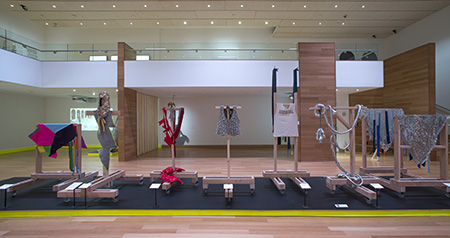
Continuing through May 5, 2020
Canadian/Anishinaabek artist Maria Hupfield (b. 1975) self-identifies as a disruptor. Here, the approach is evident even before entering the gallery. We must first pass through a space containing objects associated with indigenous artists, such as pottery and baskets. Hupfield immediately upends the colonizing nature of that introduction with four horizontal lines that carry the eye from one space to the other. Coupled with a large-scale mural of the artist in performance, these lines signal important themes in her work: Art can’t be contained in fixed, static objects. Artists and their works have important relationships to one another, rather than existing in isolation. And indigenous artists populate the present, not merely the past.
Outside the gallery stands a vertical structure, constructed from untreated lumber, where we find a video of the artist wearing a balaclava (“Ahn Ahn Ahn Kaa Kaa Kaa,” 2013-2017). Made with industrial grey felt, the headpiece is covered with tin jingles activated by the artist repeatedly shaking her head in “yes” and “no” motions. This video fixes our gaze on this artist in particular, countering the tendency of some to homogenize indigenous peoples. Lumber and felt are prevalent in this body of work, which was created during nine years spent in Brooklyn. Through her choice of materials, the artist rejects the binary of craft versus fine art. She disrupts gender stereotypes as well, in part by painting two-by-fours with the yellow color often associated with construction sites dominated by men.
The exhibition, curated by Erin Joyce, features more than 40 conceptual works. A row of vertically-placed two-by-fours suggests the backdrop of a stage, hinting at the artist’s return for future performances. Wooden armatures that hold objects with casters that connote movement. Jingle gloves and striking gloves are set inside vitrines equipped with ventilation-like holes, as if the objects might need to breath or the viewer might need to hear them. The second floor gallery is comprised of an archive culled from prior performances. The exhibit spills out of the gallery space into an adjacent courtyard, where a pair of benches (“KA-POW!” and “ZIG ZAG”) made in 2017 with untreated lumber and yellow acrylic paint serve as social sculptures. Shaped like sharp-edged cartoon thought bubbles, they beckon us to sit amid the trees. They’re placed near a site-specific photographic self-portrait (“Waaschign: Phoenix,” 2019) manipulated by the artist to play with perceptions of time and space. Hupfield stands atop a roof, overlooking a cluttered urban landscape, holding a painting created by her mother.
Throughout the exhibit, the artist calls attention to the human body. On a gallery wall, she’s placed a self-portrait cut from grey felt (“Silhouette,” 2019), installed between two videos depicting her own body in motion. In one, she’s rhythmically jumping, her feet adorned in grey felt jingle boots. Without the body, the boots would sit silent. In the other, Hupfield uses her body to manipulate the soft sculpture of a canoe that serves, in part, as a vessel of memory. The artist elevates the bodies of femme, women, and women-identifying artists by creating collaborative performances in museum spaces, where the long trajectory of art history has been dominated by male artists and the male gaze. Collaborators include DJ Miss Ginger and poet Natalie Diaz. Through performative actions and materiality, the artist creates and sustains a powerful intersection of feminism and indigeneity, propelling it forward in ways that challenge colonizing narratives about what constitutes art and who gets to create it.
